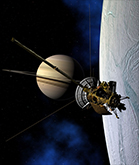The Terence Dickinson Memorial Keynote Speaker
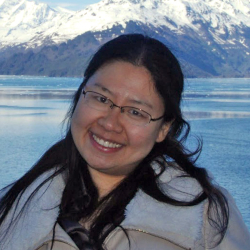
Dr. Ting Li
Sponsored by Astronomy Plus
Illuminating the Dark Universe: How Cosmic Surveys Uncover Dark Matter (and Black Holes)
Dark matter is one of the most tantalizing mysteries in astrophysics -- shaping entire galaxies yet remaining invisible to our telescopes. Our understanding of the universe has been transformed by large-scale surveys that precisely map the positions, brightnesses, and motions of billions of stars and galaxies. In this talk, I will highlight how these modern observations are helping astronomers constrain the fundamental physics of dark matter, deepening our understanding of its properties and complementing work done in particle physics labs. Finally, I will introduce the Southern Stellar Stream Spectroscopic Survey (S⁵), a program I lead that “weighs” the Milky Way by charting streams of stars to probe the distribution of dark matter, and has recently produced a surprise discovery hinting at an unexpected connection with black holes.
Biography:
Ting Li is an Assistant Professor of Astronomy and Astrophysics at the University of Toronto whose research centers on studying the Milky Way and neighboring galaxies to shed light on the nature of dark matter. Born and raised in Shanghai, China, she earned a bachelor’s degree in physics with a minor in diplomacy from Fudan University, followed by an Erasmus Mundus Master’s in Space Science and Technology, and then a PhD at Texas A&M University. Li’s work combines vast astronomical survey data with observations on some of the world’s largest optical and infrared telescopes, revealing new insights into star formation processes and dark matter’s elusive properties. She has held several prestigious fellowships, including the Leon Lederman Fellowship at Fermilab and joint appointments as a NASA Hubble Fellowship Program Einstein Fellow and a Carnegie–Princeton Fellow, before joining the University of Toronto. Additionally, Li actively engages in the development of astronomical instruments and contributes to the infrastructure of groundbreaking sky surveys such as the Dark Energy Survey (DES) and the Dark Energy Spectroscopic Instrument (DESI), in which she also serves roles as the working group chairs.
Keynote Speakers (alphabetically)

Dr. Mike Hudson
Sponsored by Telescopes Canada
Cosmic Mirages: Seeing Dark Matter with Gravitational Lenses
Most of the matter in the Universe is dark matter: an elusive particle that is completely invisible. But we can “see” this matter by studying how it distorts the light from galaxies in the distant Universe, a phenomenon called gravitational lensing. I will give a whirlwind tour of gravitational lensing’s “greatest hits” showing how it can be used as a tool to understand some of the most mysterious things in the Universe: from black holes to the “cosmic web” of dark matter that links galaxies together. Finally, with some of the spectacular and recent lensing highlights from the Euclid space telescope.
Biography:
Mike Hudson is a professor at the University of Waterloo. He obtained his Ph.D. at Cambridge University in the United Kingdom and then held postdoctoral positions at Durham University and at the University of Victoria, the latter as a Canadian Institute for Astrophysics National Fellow. His research focusses on understanding the nature and distribution of dark matter in the Universe, and its impact on the formation of galaxies using a technique called gravitational lensing. He is the leader of the Ultraviolet Near-Infrared Optical Northern Survey Gravitational Lensing team and represents Canada on the board of the Euclid Space Telescope Consortium.
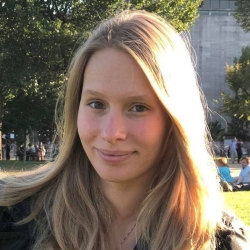
Dr. Liza Sazonova
Seeing the Unseen Lives of Galaxies
The universe is constantly changing, but much of that activity has been hidden from view — too faint, too fast, or too slow for us to catch. The Vera C. Rubin Observatory is about to change that. With its ten-year Legacy Survey of Space and Time, Rubin will map the night sky over and over again, helping us track how galaxies grow, interact, and evolve. It will also capture short-lived events like supernovae and moving objects like asteroids, giving us a fuller picture of the dynamic universe. In this talk, I’ll explore how Rubin will help us better understand the lives of galaxies — and what they can tell us about the history and future of the cosmos.
Biography:
Liza Sazonova is a postdoctoral researcher and Canadian Rubin Fellow in the Waterloo Centre for Astrophysics at the University of Waterloo. Her research focuses on studying the evolution of galaxies, and in particular how their shapes change over time. She also has interests in star formation in galaxies and machine learning, and is involved in the upcoming LSST survey at the Vera C. Rubin Observatory.
Due to circumstances beyond her control, Dr. Sazonova was not able to attend Starfest 2025. We sincerely appreciate that Dr. Syeda Lammim Ahad stepped in at the last moment for a keynote presentation on the Vera C. Rubin Observatory and her research to help us better understand our ever-changing cosmos.

Dr. Syeda Lammim Ahad
Biography:
Syeda Lammim Ahad is a WCA Postdoctoral Fellow in the Waterloo Centre for Astrophysics at the University of Waterloo. Her research is focused on understanding the formation and evolution of the largest structures in the Universe: galaxy clusters, and galaxies within these systems. She uses cosmological hydrodynamic simulations and large sky survey data to combine theory and observations in her work, and is active within the Euclid Space Telescope Consortium and the upcoming LSST survey at the Vera C. Rubin Observatory.
Guest Speakers (alphabetically):
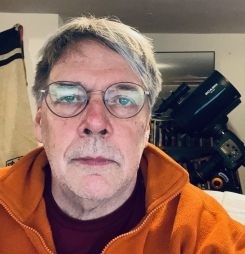
Andy Beaton
The Sky Tonight
“I’ve looked at the Moon and Saturn. Now what?” Is this you? It’s a question I get asked a lot with people who are new to astronomy, or have just shown up for an evening’s observing without a spreadsheet of all their planned observations. I’ll be talking about what we can see in the sky tonight, leaning towards the less experienced audience but throwing in a few treats for the more seasoned observers. Some of the topics will be specific for tonight, others can be taken away for future clear skies, just in case the clouds are not kind to us. Will you be observing with the good old Mark I eyeball, or a telescope you need a ladder to use? There should be something here for you to take into tonight's sky.
Biography:
Andy has been a dedicated amateur astronomer since he was 10, when his grandmother gave him a map of the universe for his birthday. Although a degree in astrophysics from U of Toronto did not lead to a career in astronomy, it did lead to a desire to do more in astronomy than observe for pleasure and into the exciting world of variable star measurement.
It also left him with a wealth of astronomical knowledge and a willingness to share it, leading to an active role in outreach and presentations at the RASC. His semi-regular Sky This Month talks are the logical end of his desire to talk about astronomy to anyone who will listen.
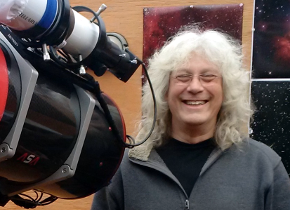
Dr. Ron Brecher
PixInsight Basics
This two-hour workshop is geared to beginners. It will cover the essentials of the PI interface and basic functions, and updating and optimizing PI.
- Minimum computer requirements
- Global Settings
- Readout Mode and the Modes Toolbar
- Projects
- Processes, Dynamic Processes and Scripts
- Process Icons and Icon Sets
- History Explorer
- Updates and Repositories
- Reset all updates
- External databases (GAIA DR3, GAIA DR3/SP, APASS DR10, MARS)
- Image window controls
- Workspaces
- View Identifier Tab functionality
- Iconize vs shade an image
- Improving performance
Photons to Photos
In this two-hour workshop I will process a monochrome SHORGB data set from beginning to end, making images in several different colour palettes. This workshop is geared to intermediate and advanced PixInsight users. Beginners are also welcome to attend to see what is possible with this powerful program.
Biography:
Ron Brecher has been an avid amateur astronomer for more than 25 years and began photographing the sky in 2004. Ron is a Contributing Editor for Sky & Telescope magazine and writes for several other publications. His deep-sky, Sun and Moon images and articles are regularly featured in books, magazines, scientific journals, calendars and more.
Ron uses PixInsight for processing his deep-sky shots. He offers private tutoring, workshops, and video tutorials online. Ron is a regular speaker at star parties and conferences in the U.S. and Canada.
Ron images from his home observatory in Guelph, Ontario where he and his wife Gail live with a dog, two cats, their daughter and her partner. In “real life,” Ron holds a PhD and is a board-certified toxicologist with more than 35 years’ consulting experience in toxicology, risk assessment and risk communication. To round things out, Ron plays guitar and lead vocals in the R&B Band “The Exceptions.”
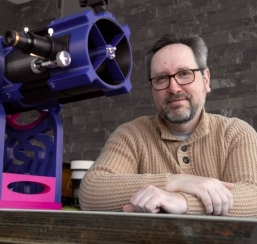
Bryan Delodder
The Accidental Telescope Factory
Bryan Delodder didn’t plan to build telescopes. After a devastating accident, he turned to CAD design and 3D printing as a way to help rebuild his life. When his young niece asked how she could get a telescope of her own, that question sparked a journey that quickly evolved into a full-fledged design effort.
Bryan's telescopes now range from beginner-friendly models to serious astrophotography instruments. Through TenTelescopes.com, his free, open-source designs have been downloaded and built by makers, educators, and astronomers around the world.
In this talk, Bryan shares how adversity, curiosity, and a simple request led to a small telescope factory. He will also present a live 3D animated walkthrough of how they’re assembled and what they can do.
The Hands-On Scope-Building Marathon
Join Bryan Delodder and the Ten Telescopes team for a four-hour workshop where you'll build a high-performance 150mm or 203mm Newtonian reflector—either a complete telescope with tripod for visual observing, or a camera-ready OTA (optical tube assembly) designed for astrophotography and compatible with your equatorial (EQ) mount.
No prior experience is needed. Each scope will be built by teams of 2–8 participants, guided by an experienced volunteer. All 3D-printed parts will be prepared in advance.
Kits are available for purchase at TenTelescopes.com. Participants who buy a kit will take home the telescope they build, complete with their choice of custom colours and customizations (Maple Leaf, Super Star, Swamp Monster etc.) if pre-ordered.
Once completed, each telescope will be collimated, tested, and set up for daytime viewing. That evening, participants will gather under the stars to explore galaxies, star clusters, nebulae, and the sweeping richness of the Milky Way—using the very telescopes they built that day.
Biography:
Bryan Delodder is a telescope maker who never meant to become one. After a serious accident ended his career in the technology sector and turned his world upside down, Bryan spent six months in the hospital teaching himself 3D printing and CAD design. One thing led to another, and now he designs telescopes, runs a public telescope library, and manages TenTelescopes.com, where you can download the plans to build your own. His story is part accident, part invention, and 100% curiosity-fueled.
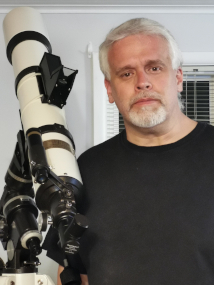
Marc Fitkin
Astronomy 101: Starting out right in Astronomy
Astronomy 101 will help the beginner astronomer navigate through equipment and literature to start them right in astronomy with the hope of cultivating a lifelong passion of the night sky. The presentation will be a mixture of lecture style and audience participation to help grow that passion.
Biography:
Marc's interest in astronomy began in his childhood as a result of a combination of the Space Shuttle Program, exposure to dark skies in Muskoka, and the film 2001: A Space Odyssey. For over 30 years, he has been enjoying nights with various telescopes and binoculars and worked in the astronomy and birding retail for over ten years. In 2019, Marc along with his wife and best friend Karen O'Kapiec-Fitkin began to look at starting a local astronomy meet up in their local village of Bronte in Oakville, Ontario. But like everything else, the world paused for the pandemic. In 2022, recognizing an opportunity and a village starving for community, Marc and Karen started The Bronte Astronomer, an informal meet up and community with public astronomy nights and an online community on Facebook with the intention of bringing astronomy to everyone in the local area and supporting existing astronomy clubs and associations.
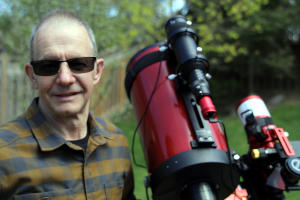
Jamie Flinn
Every Clear Night. (Field tested techniques to make best use of your gear)
Whether a visual observer or astro photographer, battling time, location and weather often means not enjoying the hobby to its fullest. Join Jamie on his multi year voyage to reach Nirvana with portable techniques and solutions to be ready in 2 minutes....whenever the sky is clear. Get answers to those deep questions like "is my gear safe outside", or "do I need a permanent observatory" and "what about emergencies and severe weather". Get the gear out of your trunk, and start enjoying the skies!
Biography:
Jamie is an avid (obsessed) amateur astrophotographer, observer, telescope maker and “futzer”. Attending StarFest since 1994 (uninterrupted except for Covid), Jamie has made, modified, fixed and MacGyver’d just about everything to do with telescopes. A proponent of Open Source and DIY Projects, he has added to community code and been a trouble-shooter in many areas, always providing insight and help to those struggling with gear and software in the dark.
Jamie is a long-time software engineer in the Aviation space, a professional support and problem-solving subject matter expert and Airline Industry Standards contributor.
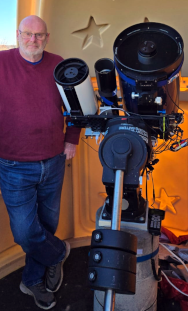
Roger Hill
Nights of Awe and Wonder: A Passion for Astronomy
A dark night sky, with the Milky Way majestically stretching across it reminds us that we're part of a vast and beautiful universe, connecting us to those who came before us who also looked up in awe and wonder. So too, when the shadow of the moon races towards us, or the very sky itself dances with pulsating light.
Astronomy is a science that has challenged the finest minds that our species has produced and yet can reduce us to the crudest of language when witnessing totality.
He will try to distill his six decades of astronomical experiences into a single informative and entertaining talk! Newcomers to the hobby will find other areas to explore; old hands will find a kindred spirit, and their long-suffering significant others will get a glimpse into that which so captivates them.
Biography:
Roger Hill has been an avid astronomer for 60 years, beginning his journey with a 4” Newtonian telescope made from porthole glass. Over the years, his collection has expanded to include six instruments, the largest being a Meade 12” SCT. All have been used for public outreach. In 1999, he presented at Starfest on building a $500 observatory. Since retiring in 2020 and moving to eastern Ontario, he now uses a SkyShed POD.
A dedicated member of the Hamilton Centre of the RASC for 55 years, Roger has served as president for six years and as the newsletter editor for twelve years. He is also a member of the Kingston Centre, currently editing their newsletter, Regulus.
Throughout his astronomy journey, Roger has witnessed several total and annular solar eclipses, lunar eclipses, transits of Mercury and Venus, and many other celestial events. Notable achievements include capturing a pre-announcement image of a supernova in M51 and a publication of his image of Venus transiting the Sun in the RASC Calendar for June 2013. In 2021, he was honored when asteroid 1989 PK was named (10076) Rogerhill.
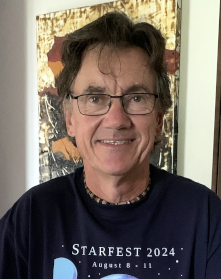
Stefan Jackson
Processing Ha Images of the Sun
The sun has just been at solar maximum and we have been lucky to have total and partial eclipses within our reach very recently. This has prompted an interest in observing and imaging our closest star. Many people have taken the plunge to purchase Ha scopes to dedicate to viewing the sun.
In this workshop, we will explore the hardware and software tools that will help you produce spectacular images of the sun, it’s surface and prominences, as well as create time lapse videos of the activity on the sun.
You can either follow along with the presentation or bring your own laptop loaded with minimally; Autostakkrt, and IMPPG. This will produce a single image. For creating time lapse you will also need PIPP. Not required for this workshop but definitely useful would be an image processing software such as PixInsight, or Photo Shop or any other image processing software available.
You will be able to download the data files we will be processing starting two weeks before Starfest by accessing the following shared google drive. You can also bring your own data to try. (I suggest you download my data as well just in case there is an issue with the data you have collected.)
Biography:
As a child, Stefan always had an interest in space. As a youngster he had a Tasco scope that barely managed to show close ups of the moon. In university he took a first year astronomy course. But mostly this interest was sidelined until 2012, when he and his wife were discussing retirement and thinking about hobbies they could do together in their golden years. That’s when they realized they both had a love of astronomy that had been put on hold by the business of life. So they bought their first scope, which led to the second scope, then the third, and so on until they now have an observatory with 4 imaging rigs, (including a solar scope) a couple of big Dobs, a couple of trackers and a trailer to go chase the dark skies. Stefan and his wife Shelley have been attending Starfest for 12 years and he has had some success in the Astroimaging contest as well as having images published in books, magazines and the RASC calendar. Besides pursuing astronomy, Stefan enjoys kayak fishing, radio controlled flying, making music and playing a variety of sports from their home near Athens, Ontario.

Ray Khan
From Starfinders to Stargone: The Rise and Fall of Meade Instruments
Meade Instruments was once the trailblazer of amateur astronomy—bringing motorized mounts, optical innovation, and affordable gear to stargazers worldwide. But behind the blue tubes and AutoStar hand controllers was a rollercoaster of bold marketing, fierce competition, and eventually… corporate collapse. In this talk, Ray Khan—one of Meade’s original Canadian dealers—charts the company’s meteoric rise, long reign, and sudden fall. Expect sharp insight, firsthand anecdotes, and a few cautionary tales from the business side of the night sky.
Biography:
Ray Khan is the founder of Khan Scope Centre and has been a fixture in the Canadian astronomy scene for over 42 years. As one of Meade Instruments’ original Canadian dealers in the early 1980s, Ray had a front-row seat to the brand’s heyday and eventual decline. A passionate backyard visual observer since the golden age of VHS and cork eyepiece cases, he’s helped thousands of amateurs find their first Saturn moment—and just as many navigate the fast-evolving telescope market. When he’s not talking scopes, he’s probably out under the stars—or convincing someone to upgrade to a better telescope mount, optical tube, or CCD camera.
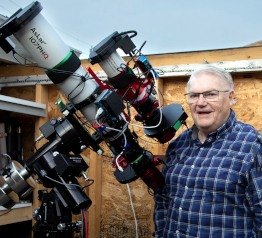
Keith Mombourquette
Imaging Automation: How To Get Some Sleep While Imaging
Are you a sleep-deprived astro-imager? Perhaps its time for you to consider automating your data collection so that you can get a good night’s sleep while your system operates to your pre-programmed instructions collecting data on the target or targets you want to capture. This can range from things as simple as determining when to autofocus and doing a focus run, to a fully automated system that will monitor the sky conditions and start or stop automatically when conditions allow.
In the last 3 years, Keith has gone from sitting beside his camera and lens on a tracker to sleeping through the night while his two and often three telescopes are happily collecting photons without worrying about changing weather conditions or power failures. Whether you are a beginner or an advanced imager there are likely things that could be automated in your workflow that would make imaging easier and encourage you to take images when you might not otherwise.
Biography:
Keith came to Astrophotography late in life. It started as an extension to his nature photography one night in March of 2022. On a whim, after photographing the northern lights he decided to turn his camera to the sky to see if he could capture an image of the Orion Nebula. He was delighted when he got home and stacked the 10 frames he had collected and was able to see the nebula. The next night he was out under the stars with his camera and lens mounted to a star tracker to try for a better image. From that point on, he was hooked.
Keith is a Professional Engineer who loves to apply his engineering skills to many aspects of his hobbies. He has used those skills to design and construct a roll-off-roof observatory which he uses any time that the sky is clear – even if only for a few hours at a time.
Keith’s images are well received by family and friends, and the local community, with whom he regularly shares them.

Dr. Jesse Rogerson
Exploring the Solar System through Daydreaming and Storytelling
Humans are natural dreamers and storytellers. Stories are how we communicate ideas, develop comprehension, empathize, and survive. Both our imagination and our ability to tell compelling stories have been central to the evolution of humanity from thousands of year ago, when we started using observations of nature to better ensure our survival, to today when we create some of the most amazing missions out into the solar system. In this presentation, I will demonstrate how, Dr. John Moores, Michelle Parsons, and I used the ideas of storytelling, imagination, and visual art to help both the authors and the reader develop a deeper understanding of the exotic locations in the solar system. This was woven together into a semi-fictional, semi-non-fictional book, called Daydreaming in the Solar System. I will read excerpts from the book, and dive deeper into the science behind some of the chapters.
Biography:
Jesse Rogerson is an Assistant Professor at York University, in the Division of Natural Science. In this role, Jesse teaches a variety of astronomy and space science classes for non-science majors. He received his MSc and PhD in astrophysics from York University, with a specialization on quasars, and his HBSc from McMaster University. After completing his PhD, Jesse took his Education and Public Outreach experience and applied in to the Museum and Science Centre industry. He held positions at the Ontario Science Centre, Telus Spark, and notably was the Science Advisor at the Canada Aviation and Space Museum in Ottawa. Now, back at York University, Jesse uses his extensive astrophysics and outreach experiences to generate conversations and engagement with the space sciences.
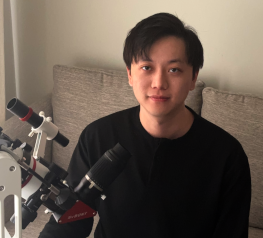
Ryan Zhu
Affordable Astrophotography: Exploring the Universe on a Budget
Astrophotography doesn’t have to break the bank. In this talk, I’ll showcase how hobbyists and amateur astronomers can capture stunning deep-sky and planetary images using affordable gear—from budget-friendly telescopes and cameras to user-friendly mounts and accessories. Drawing on real-world examples and product innovations from Svbony, I’ll demonstrate how entry-level tools can deliver surprisingly professional results. Whether you're just getting started or looking to expand your toolkit without overspending, this session is packed with practical tips, product comparisons, and inspiration.
Biography:
Ryan is the Sales Manger of North American for Svbony, Retekess, and Retevis, with a strong focus on optical and communication technology. Passionate about making astronomy accessible, he supports hobbyists, educators, and retailers across Canada and the U.S. by introducing innovative and affordable products. With a background in technology sales and customer education, Ryan regularly attends astronomy events to connect with the community and share insights on how to get the most out of entry-level equipment.
